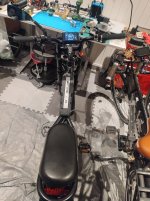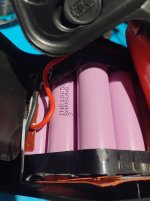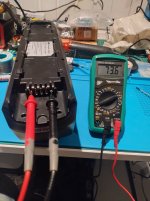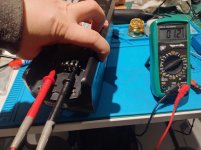This was strange though with the switch at the off position the voltage is 73.6 but when pushing at the battery gage button it dropt to 1.2v
That means the BMS turned the output off because it detected an out-of-limits condition, which is exactly what it is supposed to do.
What that limit was that was exceeded is what you have to find out, so you can prevent it from being exceeded, or repair / replace the part causing the limit to be exceeded.
The limit could be a cell or cells that have too high an internal resistance and/or too low a capacity, so they sag in voltage too far under a high enough load, and trigger the BMS's LVC, or even the difference-between-cells limit. Or it could be overcurrent, the controller drawing too much current at powerup/inrush. Etc.
I have not really tried this pack under high load for a long ride to much snow and ice where i live right now.
The display does show volts, with me on the bike it drops from 81,5v to 75-76v when taking off.
If it's normal full voltage is 81.5v, then if it's a 20s pack (typical for "72v"), they're only charging to 4.075v each (assuming perfect cell matching and thus balance).
If they sag to 75v under startup load (how many amps?) that's 3.75v each, so they're sagging almost down to "half full" status. Each cell is losing 0.325v, or nearly 10% of it's voltage.
Also, the actual drop could be much worse, since many of the voltmeters on these things don't update very fast or often, so you might miss the worst of the voltage drop before the load drops.
Picking a random Samsung 35E cell (since you said they're samsungs, but not which ones and it's not fully readable in the pics) from Lgyte's testing:
According to the discharge chart there, if they start at about 4v unloaded, they're probably only about 3/4 full (or less), based on the lowest-current load line and assuming minimal voltage drop from that.
To drop down to 3.75v from that point, they're probably seeing about a 3A load or so, per cell. At a guess, the pack is probably 4 or 5p, so 12-15A load when you're starting up from a stop. You'd have to verify that with a multimeter.
Knowing if this is actually true or not, you can compare your actual voltage sag to the actual current per cell and guess if the cells you have match the testing done by Lgyte, and the cell specs.
Then that, along with whether all the cells are exactly equal in voltage at that point (and when full, and when empty) will tell you if they are meeting actual cell specs and whether they are matched to each other.
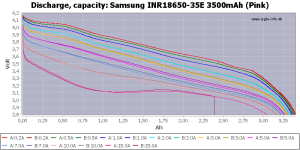
I opend the pack and took a look at the cells, they are samsung.
Brand doesn't matter, directly (it isn't a useful indicator of whether a pack is any good or not).
Cell specs and quality (how closely the actual cells come to meeting the specs of that specific model), vs actual usage requirements, as well as how closely matched the cells are to each other, are what matter.
The last part is usually the problem--the cells don't usually come even remotely close to matching each other's characteristics.
The first part is another separate problem that might not apply to your setup--most of the packs people buy aren't actually able to handle the loads they put on them, because the purchasers usually get whatever says it will (barely) meet the current limits of the



